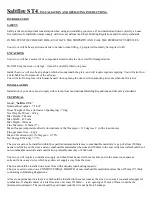
34
Incidents
• The glass door soots up
Solution
•
The fire in the burning chamber is not hot enough. Open for the secondary air and the soot
will burn off quickly.
•
The wood is too moist.
•
A lack of draught in the chimney.
4.0. Safety
The surface of the stove as well as knobs, handle, window, smoke pipe etc. becomes very hot
when the stove is in use. Touching of these parts without necessary protection (glove or other
forms of protective material) can lead to burns.
Remember to make children aware of this danger and make sure to keep them away from the
stove when in use. For this purpose, TermaTech offers various grates for protection of children
and pets.
5.0. Important and helpful advice
5.1. Lighting wood / - sticks
Kindling sticks is a term for small finely chopped wooden pieces that are approx. 18 to 20 cm long
and have a diameter of 2-3 cm. Wood like birch, beech, oak, ash, elm, pine wood and wood from
fruit trees are all suitable as firewood.
5.2. Firewood
Wood like birch, beech, oak, ash, elm, pine wood and wood from fruit trees are all suitable as
firewood.
Firewood should have a diameter of 7-10 cm and the length should not be more than the width of
the combustion chamber minus 4cm (width of the combustion chamber can be found under 11.0)
, otherwise it will get too close to the side of the stove. The most important thing for good com-
bustion is that the wood is dry (12-20% moisture) See section 5.8 Firewood storage.
If the firewood is too wet it is difficult to get it to burn, the chimney draught is non-existent, there
is a lot of smoke and the exploitation is lower as the water has to evaporate first. Furthermore,
there may be damage to the stove and the chimney in the shape of shinning soot and tarry depo-
sits. At worst it can lead to a chimney fire.
If the wood is too dry it will burn too quickly. The gasses in the wood are released faster than
they can burn and some go unburned through the chimney. This also gives a lower exploitation
and harms the environment. It is about finding a balance which is easy with a bit of practice.
5.3. Lighting after a longer break
If the stove has not been in use for a long time, the chimney should be checked for possible
blockage before lighting (birds nest etc.). Furthermore, it is a good idea to remove any dust from
the wood-burning stove as it might smell after a long break.
5.4. Chimney fire
In the event of a chimney fire the doors, drawers and dampers of the wood-burning stove must
be closed immediately in order to cut the oxygen supply. The relevant authorities must be notified
if necessary. The stove and chimney must not be used until the chimney has been inspected.
5.5. Lighting with waste products
Lighting with waste products like pressure treated wood, chipboard, coloured brochure or glossy
paper is not allowed in the wood-burning stove. They develop hydrochloric acid and heavy metals
which cause damage to the stove and to the environment. The warranty is annulled if the above
is used in the stove.
5.6. Bio-briquettes
Bio-briquettes can be used but they create a lot of ash and dust. Put in max. 2 kg. at a time.
Please note that the stove is not approved for bio-briquettes/wood briquettes at the Technological
Institute of Denmark.
5.7. Energy coke
Energy coke must not be used in the wood-burning stove as it contains a lot of Sulphur which
wears on the stove, the chimney and the environment. The life of the stove and chimney will be
significantly reduced by using this firing type and the right claim compensation for the product
will be annulled.
5.8. Firewood storage
We recommend storing the wood under a roof however with good ventilation, perhaps in a carport
Содержание S01-628
Страница 1: ...1 TT80RL TT80RLS DK 2 DE 16 UK 29 NO 73 SE 60 FR 47...
Страница 14: ...14...
Страница 87: ...87 www termatech com TermaTech AS DK 8260 Viby J Tlf 45 8742 0035 99 286 version 01 2020...
















































